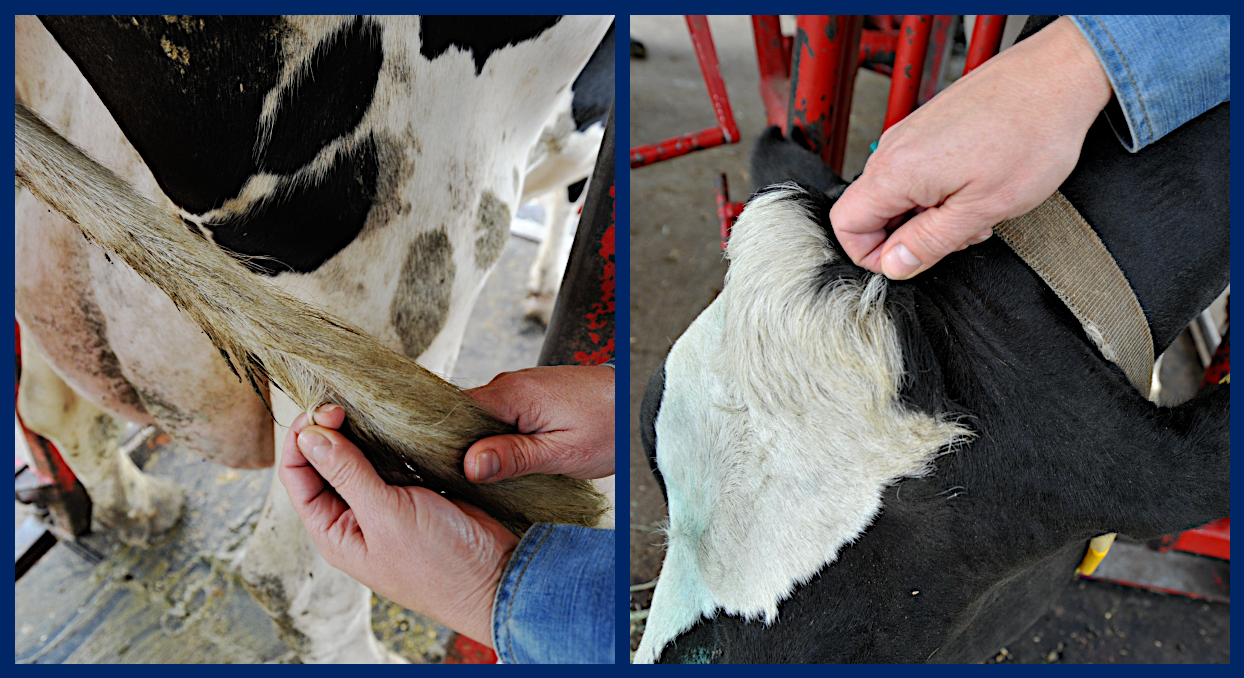Quick Summary
Click here for Price and Turnaround Time
Phenotype: Cattle with the dominant black allele are jet black (solid or spotted); wild type cattle have reddish brown to brownish black base coloration with a tan muzzle ring; cattle with two copies of the recessive red allele have a red base coloration.
Mode of Inheritance: Autosomal recessive, order of dominance is ED > E+ > e
Alleles: ED = Dominant black, E+ = Wild type, e = Recessive red
Breeds appropriate for testing: Many breeds (excluding Holsteins—see separate Holstein-specific MC1R test)
Explanation of Results:
- Cattle with ED/ED genotype will have a jet black base color and cannot produce red offspring. They will transmit this dominant black variant to all of their offspring.
- Cattle with ED/E+ genotype will have a jet black base color and are carriers of the wild type variant. They will transmit this wild type variant to 50% of their offspring. Matings between two wild type carriers result in a 25% chance of producing a calf with wild type base coloration.
- Cattle with ED/e genotype will have a jet black base color and are carriers of the recessive red variant. They will transmit this recessive red variant to 50% of their offspring. Matings between two recessive red carriers result in a 25% chance of producing a calf with recessive red base coloration.
- Cattle with E+/E+ genotype will have wild type base coloration (reddish brown to brownish black base coloration). They will transmit this wild type variant to all of their offspring.
- Cattle with E+/e genotype will have wild type base coloration (reddish brown to brownish black base coloration) and are carriers of the recessive red variant. They will transmit this recessive red variant to 50% of their offspring. Matings between two recessive red carriers result in a 25% chance of producing a calf with recessive red base coloration.
- Cattle with e/e genotype will have red base coloration. They will transmit this recessive red variant to all of their offspring. All calves produced from matings with other e/e genotype cattle will have recessive red base coloration.
Note: Overall appearance of the cattle's coat also depends on expression of and complex interactions with other genes (for example, genes that add white spotting, genes that affect pigment distribution, and genes that dilute pigments).
$30 one test per animal
Also available as part of the following Dexter breed-specific packages:
$40 this test + one test from list below
$50 this test + two tests from list below
$60 this test + all tests from list below
- Dun Coloration in Dexters
- Dexter BD1 Bulldog Dwarfism (Note: $75 flat fee for Bulldog Dwarfism BD2 test)
- Pulmonary Hypoplasia with Anasarca (PHA) in Dexters
Sample Collection
Most of the cattle DNA tests offered by the VGL are carried out using cells from the roots of a hair sample (roughly 20-40 hairs).
Hair samples should be taken from the switch of the tail, the poll, or the neck.

1. Clean (use comb if possible) tail switch, poll, or neck by removing all loose hair and foreign matter.
2. Use fingers or pliers to grasp approximately 8-10 hairs close to the skin and pull. Pull (do NOT cut) hair strands. Examine the end of hair strands for presence of root bulbs. Hair roots are necessary for DNA testing. If the majority of hair strands lack the root bulbs, discard hair and start again.
3. Repeat until you have approximately 20-40 hairs with root follicles attached.
4. Place the 20-40 hairs with root follicles attached in the envelope and seal with the animal’s ID written on the envelope. If hairs are long they can be taped to the submission form. Do not tape the roots.

5. Repeat steps 1-4 for each additional animal being sampled.
Note:
- Hair should be dry.
- If hair has excess dirt and debris, please brush out if possible before pulling hairs for sample.
- Do not cut the hair! The roots contain the DNA for testing.
- When sampling several animals in the same session, make sure that there are no hair strands in your hands to reduce the possibility of sample contamination. Clean hands and/or pliers if possible.
Several genes are involved in the process of creating the complex coat colors and patterns found in domestic cattle. One of these is the Melanocortin 1 Receptor (MC1R) gene, also called Extension, that controls the production of black (eumelanin) and red (phaeomelanin) pigments. The three alleles (forms or variants) of this gene are dominant black (ED), Wild type (E+), and recessive red (e).
Dominant black (ED) is dominant to the other two alleles, and animals with this allele are jet black (solid or spotted). The Wild type (E+) produces cattle with reddish brown to brownish black coloration with a tan muzzle ring. Two copies of the recessive red (e) allele will result in red color. Other coat color genes act as modifiers of these base colors, adding white spotting patterns, reorganizing the distribution of red and black pigments (Brindle and Agouti), or diluting the pigments (Dun, Charolais dilution, and Simmental diution).
